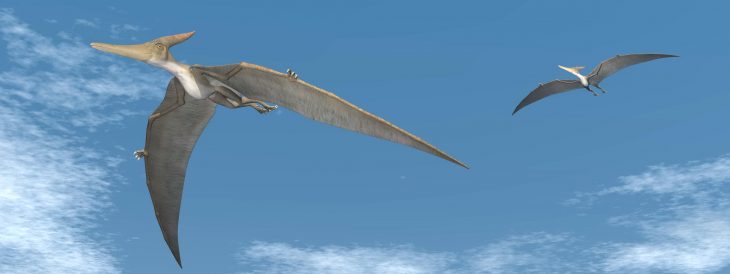
Pterodactyls have quite an iconic reputation among prehistoric animals, thanks to their ability to fly. This made them stand out, when at that time, only insects could fly. Ironically, pterodactyls actually remain one of the more mysterious dinosaurs we know about today. Learn more about these prehistoric animals with these 30 pterodactyl facts.
- Scientists have discovered an estimated 30 fossilized pterodactyl specimens so far.
- Pterodactyls had an estimate of 90 teeth.
- Some pterodactyl species featured bony crests up to 46 mm long on their heads.
- However, these crests typically only had a height of around 1 mm.
- Pterodactyls measured around 1 meter from the tip of one wing to the tip of their other wing.
- Humans first discovered pterodactyls fossils in 1779.
- Cosimo Collini first described pterodactyls in 1784.
- Scientists at the time actually thought pterodactyls had an aquatic lifestyle.
- Johann Hermann first considered pterodactyls as flight-capable creatures in 1800, but saw them as a form of bat.
- Georges Cuvier agreed with Hermann, but disagreed that pterodactyls counted as mammals.
- Cuvier also became the first to use the name pterodactyl in 1809.
- Samuel von Sommering continued to support the idea of pterodactyls as mammals in 1810.
- Cuvier countered von Sommering’s position in 1812.
- Only a minority of scientists still thought of pterodactyls as aquatic by 1830.
- Pterodactyl fossils incorrectly thought to belong to a crustacean, became correctly recognized in 1856.
- Most pterodactyl fossils come from Bavaria in Germany.
- Pterodactyl fossils usually lie near those of Archaeopteryx and Compsognathus.
- Scientists also found Ichthyosaur fossils nearby.
- Other fossils nearby also belonged to prehistoric crocodiles, turtles, and fish.
- Scientists have even found rare jellyfish fossils nearby.
Was this page helpful?
Our commitment to delivering trustworthy and engaging content is at the heart of what we do. Each fact on our site is contributed by real users like you, bringing a wealth of diverse insights and information. To ensure the highest standards of accuracy and reliability, our dedicated editors meticulously review each submission. This process guarantees that the facts we share are not only fascinating but also credible. Trust in our commitment to quality and authenticity as you explore and learn with us.


